BSBCRT511: Critical & Creative Thinking Development at Bounce Fitness
VerifiedAdded on 2023/06/16
|62
|13271
|333
Case Study
AI Summary
This case study, designed for BSBCRT511, delves into the development of critical and creative thinking skills within a simulated workplace environment, Bounce Fitness. It requires researching models, concepts, and approaches related to both critical and creative thinking. The tasks include identifying knowledge gaps in team members, facilitating learning opportunities to address these gaps, articulating key features of critical and creative thinking, and collecting feedback on these initiatives. The case study is divided into four parts, including assessing individual and team skills, establishing a supportive environment, facilitating application opportunities, and improving practices. The solution provides a detailed exploration of Taylor's model of critical thinking and the action management creative thinking model, along with various concepts and approaches applicable in a workplace setting. It emphasizes the importance of analytical thinking, communication, interpersonal skills, curiosity, divergent thinking, and convergent thinking in fostering a culture of critical and creative thought.
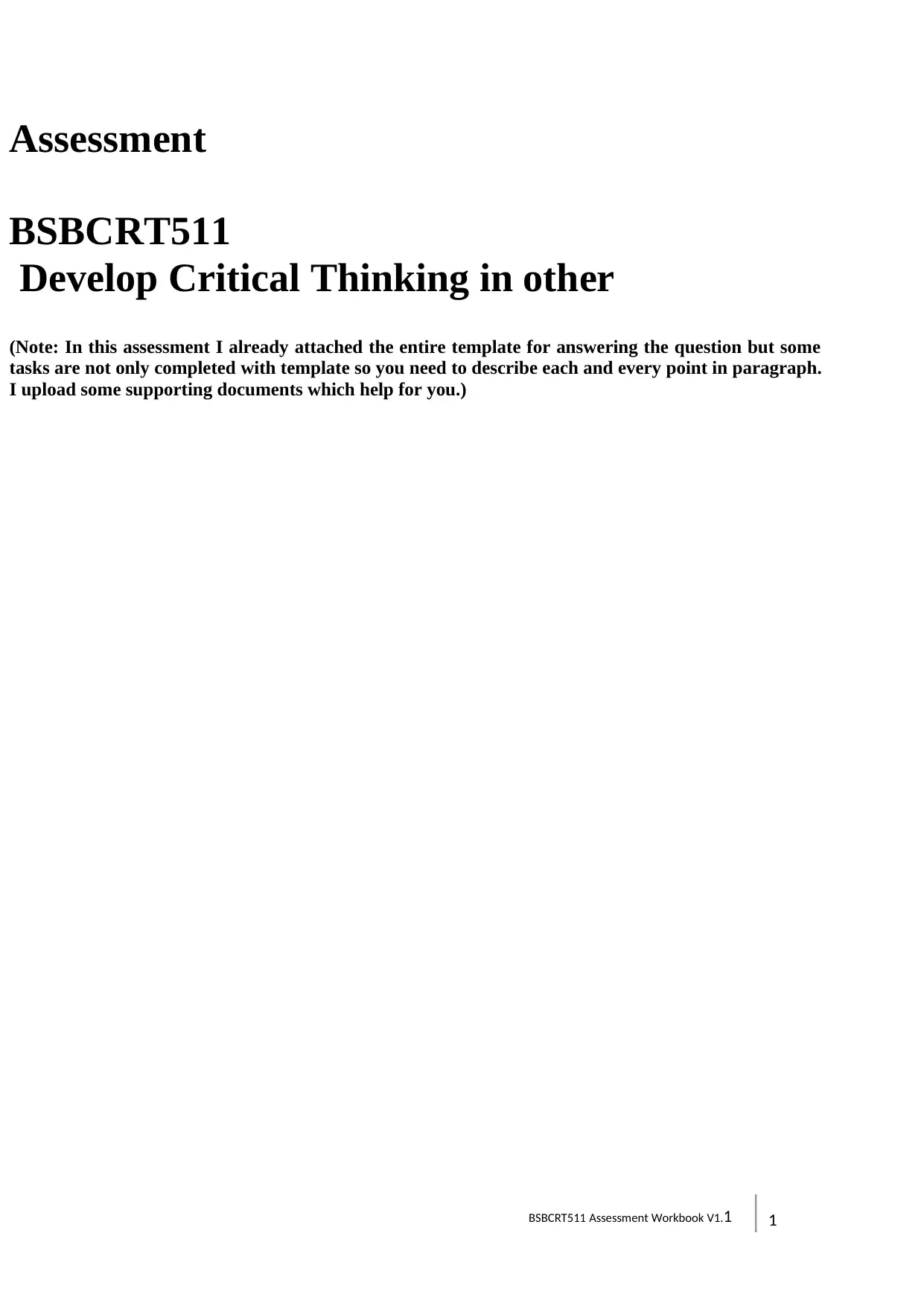
1BSBCRT511 Assessment Workbook V1.1
Assessment
BSBCRT511
Develop Critical Thinking in other
(Note: In this assessment I already attached the entire template for answering the question but some
tasks are not only completed with template so you need to describe each and every point in paragraph.
I upload some supporting documents which help for you.)
Assessment
Workbook
BSBCRT511
Develop critical
Assessment
BSBCRT511
Develop Critical Thinking in other
(Note: In this assessment I already attached the entire template for answering the question but some
tasks are not only completed with template so you need to describe each and every point in paragraph.
I upload some supporting documents which help for you.)
Assessment
Workbook
BSBCRT511
Develop critical
Paraphrase This Document
Need a fresh take? Get an instant paraphrase of this document with our AI Paraphraser
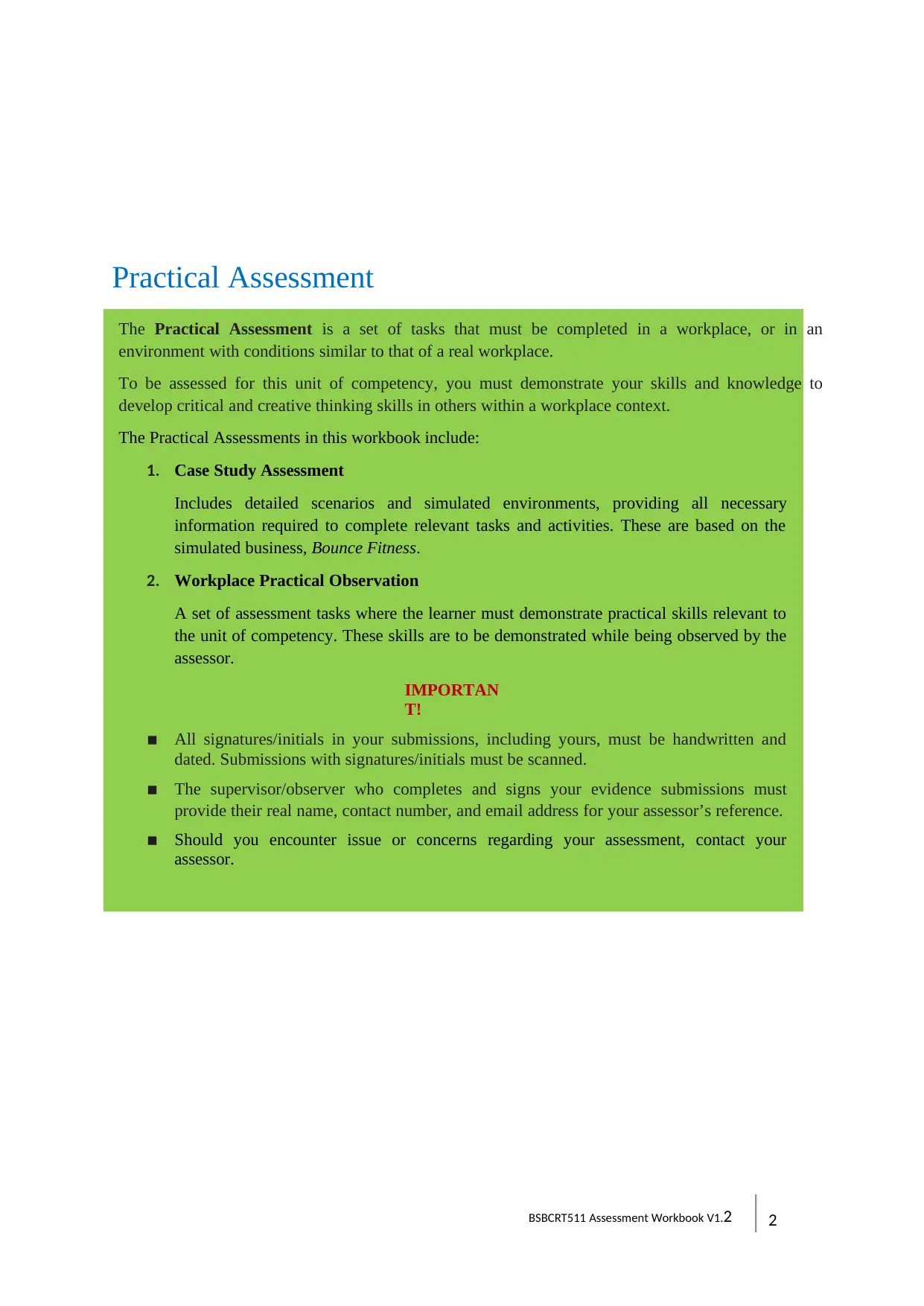
2BSBCRT511 Assessment Workbook V1.2
Practical Assessment
The Practical Assessment is a set of tasks that must be completed in a workplace, or in an
environment with conditions similar to that of a real workplace.
To be assessed for this unit of competency, you must demonstrate your skills and knowledge to
develop critical and creative thinking skills in others within a workplace context.
The Practical Assessments in this workbook include:
1. Case Study Assessment
Includes detailed scenarios and simulated environments, providing all necessary
information required to complete relevant tasks and activities. These are based on the
simulated business, Bounce Fitness.
2. Workplace Practical Observation
A set of assessment tasks where the learner must demonstrate practical skills relevant to
the unit of competency. These skills are to be demonstrated while being observed by the
assessor.
IMPORTAN
T!
▪ All signatures/initials in your submissions, including yours, must be handwritten and
dated. Submissions with signatures/initials must be scanned.
▪ The supervisor/observer who completes and signs your evidence submissions must
provide their real name, contact number, and email address for your assessor’s reference.
▪ Should you encounter issue or concerns regarding your assessment, contact your
assessor.
Practical Assessment
The Practical Assessment is a set of tasks that must be completed in a workplace, or in an
environment with conditions similar to that of a real workplace.
To be assessed for this unit of competency, you must demonstrate your skills and knowledge to
develop critical and creative thinking skills in others within a workplace context.
The Practical Assessments in this workbook include:
1. Case Study Assessment
Includes detailed scenarios and simulated environments, providing all necessary
information required to complete relevant tasks and activities. These are based on the
simulated business, Bounce Fitness.
2. Workplace Practical Observation
A set of assessment tasks where the learner must demonstrate practical skills relevant to
the unit of competency. These skills are to be demonstrated while being observed by the
assessor.
IMPORTAN
T!
▪ All signatures/initials in your submissions, including yours, must be handwritten and
dated. Submissions with signatures/initials must be scanned.
▪ The supervisor/observer who completes and signs your evidence submissions must
provide their real name, contact number, and email address for your assessor’s reference.
▪ Should you encounter issue or concerns regarding your assessment, contact your
assessor.
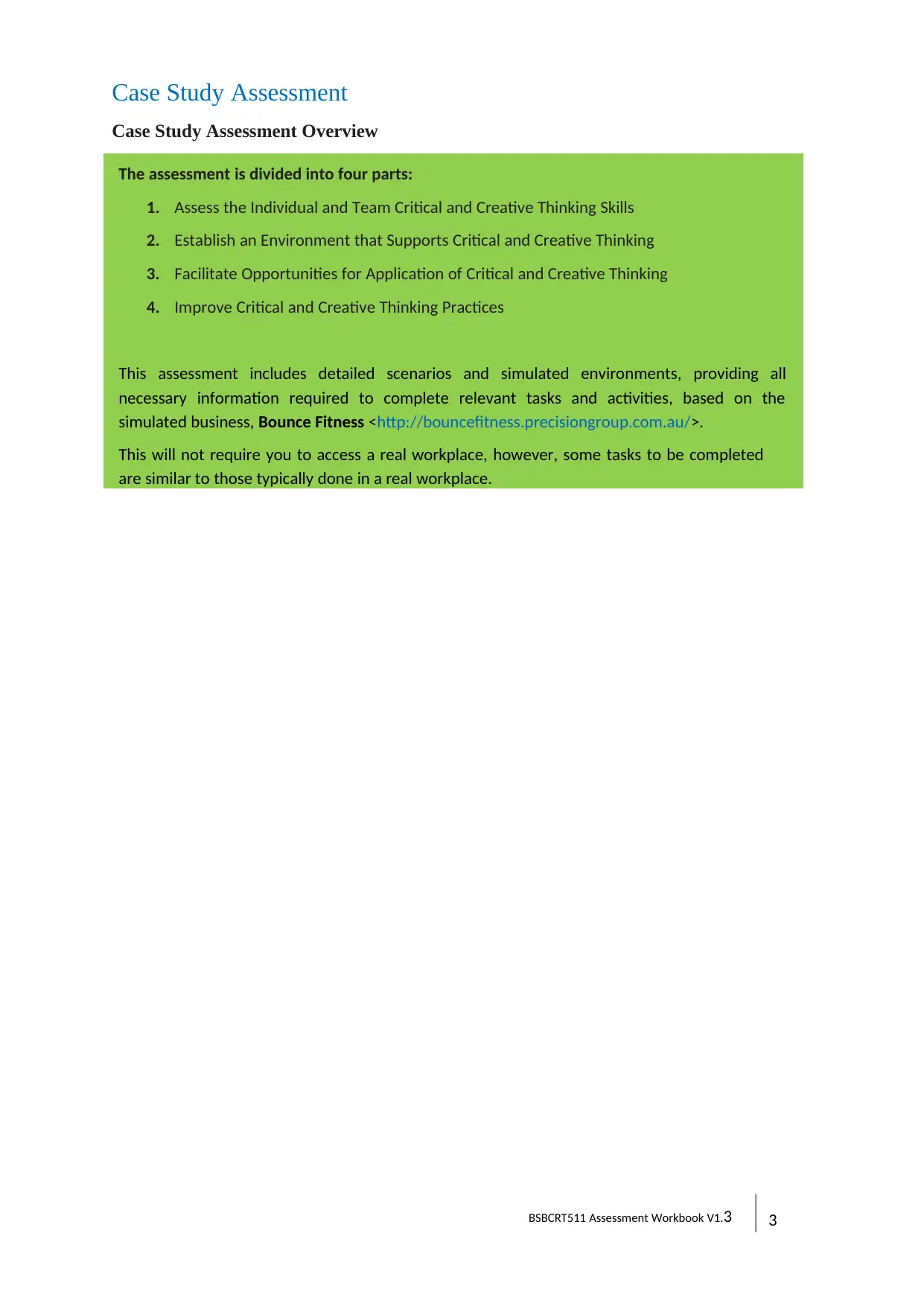
3BSBCRT511 Assessment Workbook V1.3
Case Study Assessment
Case Study Assessment Overview
The assessment is divided into four parts:
1. Assess the Individual and Team Critical and Creative Thinking Skills
2. Establish an Environment that Supports Critical and Creative Thinking
3. Facilitate Opportunities for Application of Critical and Creative Thinking
4. Improve Critical and Creative Thinking Practices
This assessment includes detailed scenarios and simulated environments, providing all
necessary information required to complete relevant tasks and activities, based on the
simulated business, Bounce Fitness <http://bouncefitness.precisiongroup.com.au/>.
This will not require you to access a real workplace, however, some tasks to be completed
are similar to those typically done in a real workplace.
Case Study Assessment
Case Study Assessment Overview
The assessment is divided into four parts:
1. Assess the Individual and Team Critical and Creative Thinking Skills
2. Establish an Environment that Supports Critical and Creative Thinking
3. Facilitate Opportunities for Application of Critical and Creative Thinking
4. Improve Critical and Creative Thinking Practices
This assessment includes detailed scenarios and simulated environments, providing all
necessary information required to complete relevant tasks and activities, based on the
simulated business, Bounce Fitness <http://bouncefitness.precisiongroup.com.au/>.
This will not require you to access a real workplace, however, some tasks to be completed
are similar to those typically done in a real workplace.
⊘ This is a preview!⊘
Do you want full access?
Subscribe today to unlock all pages.

Trusted by 1+ million students worldwide
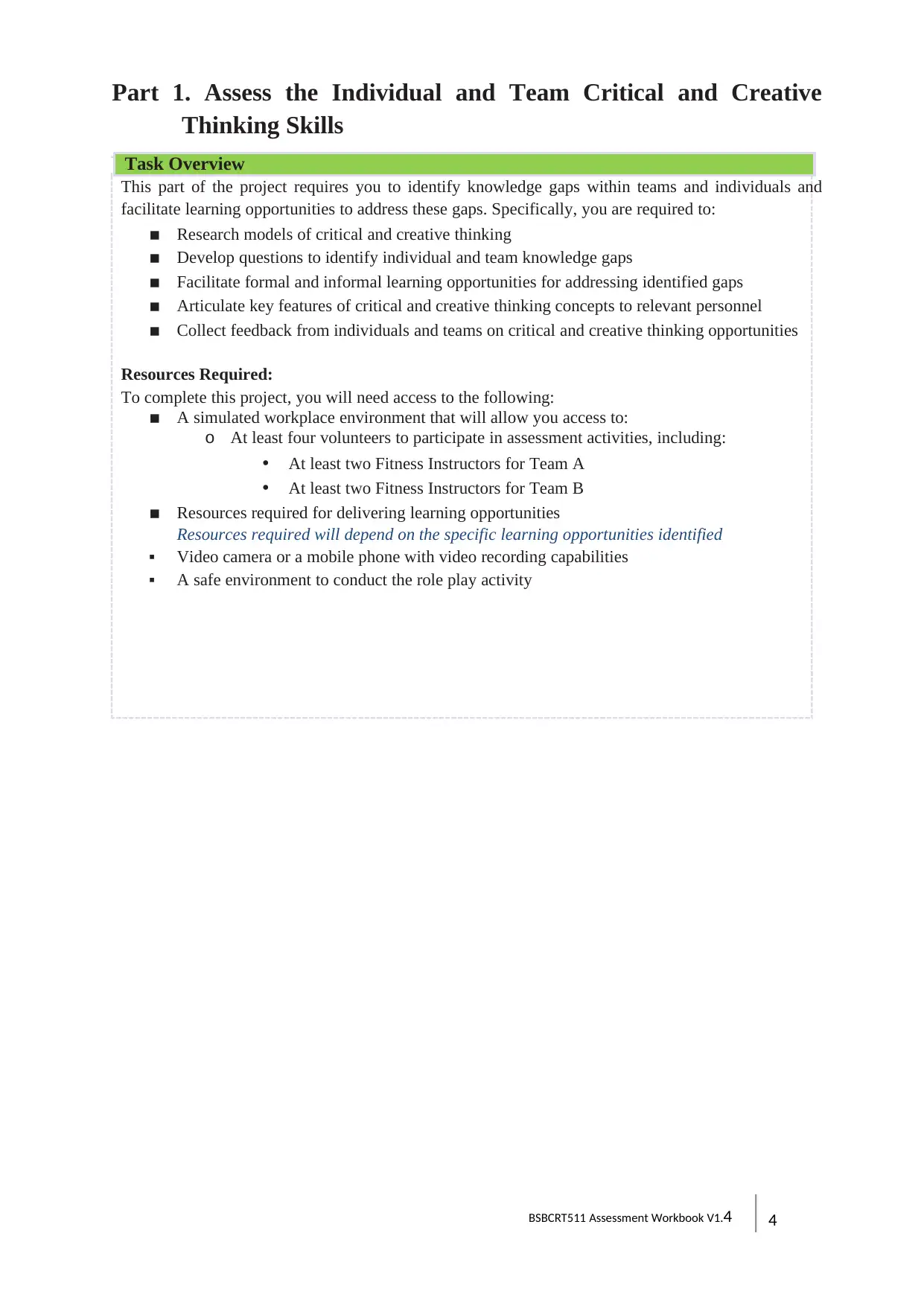
4BSBCRT511 Assessment Workbook V1.4
Part 1. Assess the Individual and Team Critical and Creative
Thinking Skills
Task Overview
This part of the project requires you to identify knowledge gaps within teams and individuals and
facilitate learning opportunities to address these gaps. Specifically, you are required to:
▪ Research models of critical and creative thinking
▪ Develop questions to identify individual and team knowledge gaps
▪ Facilitate formal and informal learning opportunities for addressing identified gaps
▪ Articulate key features of critical and creative thinking concepts to relevant personnel
▪ Collect feedback from individuals and teams on critical and creative thinking opportunities
Resources Required:
To complete this project, you will need access to the following:
▪ A simulated workplace environment that will allow you access to:
o At least four volunteers to participate in assessment activities, including:
• At least two Fitness Instructors for Team A
• At least two Fitness Instructors for Team B
▪ Resources required for delivering learning opportunities
Resources required will depend on the specific learning opportunities identified
▪ Video camera or a mobile phone with video recording capabilities
▪ A safe environment to conduct the role play activity
Part 1. Assess the Individual and Team Critical and Creative
Thinking Skills
Task Overview
This part of the project requires you to identify knowledge gaps within teams and individuals and
facilitate learning opportunities to address these gaps. Specifically, you are required to:
▪ Research models of critical and creative thinking
▪ Develop questions to identify individual and team knowledge gaps
▪ Facilitate formal and informal learning opportunities for addressing identified gaps
▪ Articulate key features of critical and creative thinking concepts to relevant personnel
▪ Collect feedback from individuals and teams on critical and creative thinking opportunities
Resources Required:
To complete this project, you will need access to the following:
▪ A simulated workplace environment that will allow you access to:
o At least four volunteers to participate in assessment activities, including:
• At least two Fitness Instructors for Team A
• At least two Fitness Instructors for Team B
▪ Resources required for delivering learning opportunities
Resources required will depend on the specific learning opportunities identified
▪ Video camera or a mobile phone with video recording capabilities
▪ A safe environment to conduct the role play activity
Paraphrase This Document
Need a fresh take? Get an instant paraphrase of this document with our AI Paraphraser
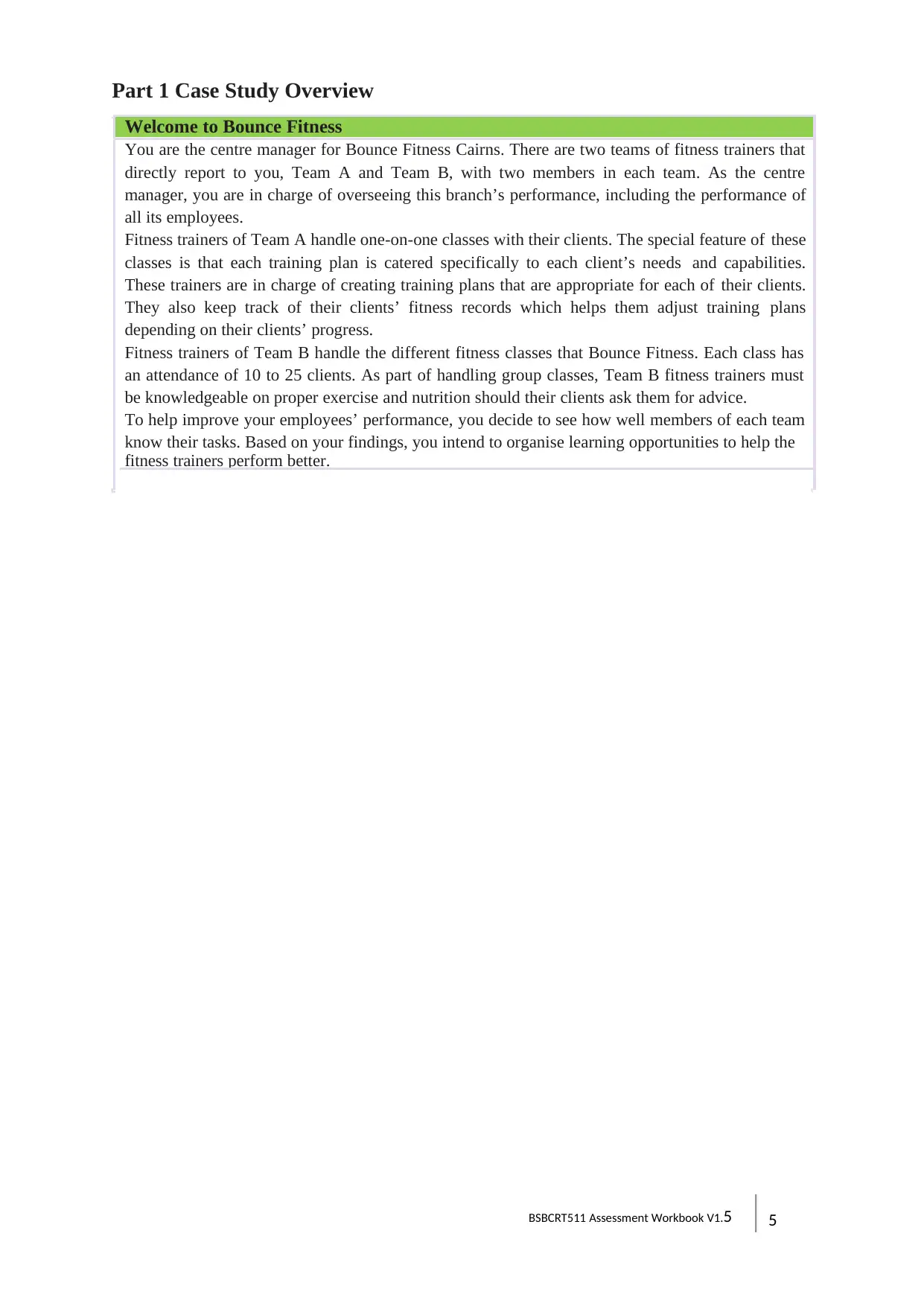
5BSBCRT511 Assessment Workbook V1.5
Part 1 Case Study Overview
Welcome to Bounce Fitness
You are the centre manager for Bounce Fitness Cairns. There are two teams of fitness trainers that
directly report to you, Team A and Team B, with two members in each team. As the centre
manager, you are in charge of overseeing this branch’s performance, including the performance of
all its employees.
Fitness trainers of Team A handle one-on-one classes with their clients. The special feature of these
classes is that each training plan is catered specifically to each client’s needs and capabilities.
These trainers are in charge of creating training plans that are appropriate for each of their clients.
They also keep track of their clients’ fitness records which helps them adjust training plans
depending on their clients’ progress.
Fitness trainers of Team B handle the different fitness classes that Bounce Fitness. Each class has
an attendance of 10 to 25 clients. As part of handling group classes, Team B fitness trainers must
be knowledgeable on proper exercise and nutrition should their clients ask them for advice.
To help improve your employees’ performance, you decide to see how well members of each team
know their tasks. Based on your findings, you intend to organise learning opportunities to help the
fitness trainers perform better.
Part 1 Case Study Overview
Welcome to Bounce Fitness
You are the centre manager for Bounce Fitness Cairns. There are two teams of fitness trainers that
directly report to you, Team A and Team B, with two members in each team. As the centre
manager, you are in charge of overseeing this branch’s performance, including the performance of
all its employees.
Fitness trainers of Team A handle one-on-one classes with their clients. The special feature of these
classes is that each training plan is catered specifically to each client’s needs and capabilities.
These trainers are in charge of creating training plans that are appropriate for each of their clients.
They also keep track of their clients’ fitness records which helps them adjust training plans
depending on their clients’ progress.
Fitness trainers of Team B handle the different fitness classes that Bounce Fitness. Each class has
an attendance of 10 to 25 clients. As part of handling group classes, Team B fitness trainers must
be knowledgeable on proper exercise and nutrition should their clients ask them for advice.
To help improve your employees’ performance, you decide to see how well members of each team
know their tasks. Based on your findings, you intend to organise learning opportunities to help the
fitness trainers perform better.
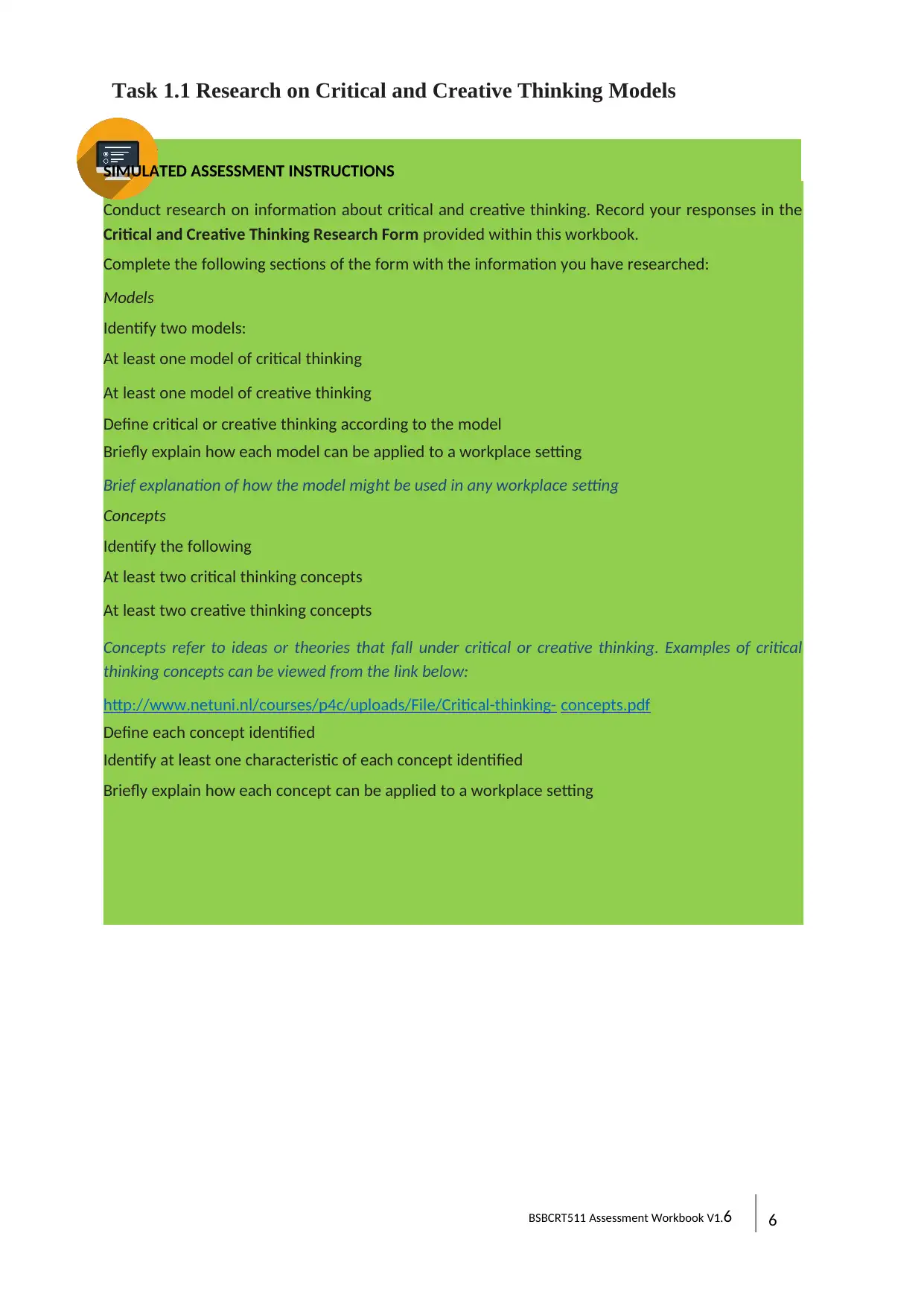
6BSBCRT511 Assessment Workbook V1.6
Task 1.1 Research on Critical and Creative Thinking Models
SIMULATED ASSESSMENT INSTRUCTIONS
Conduct research on information about critical and creative thinking. Record your responses in the
Critical and Creative Thinking Research Form provided within this workbook.
Complete the following sections of the form with the information you have researched:
Models
Identify two models:
At least one model of critical thinking
At least one model of creative thinking
Define critical or creative thinking according to the model
Briefly explain how each model can be applied to a workplace setting
Brief explanation of how the model might be used in any workplace setting
Concepts
Identify the following
At least two critical thinking concepts
At least two creative thinking concepts
Concepts refer to ideas or theories that fall under critical or creative thinking. Examples of critical
thinking concepts can be viewed from the link below:
http://www.netuni.nl/courses/p4c/uploads/File/Critical-thinking- concepts.pdf
Define each concept identified
Identify at least one characteristic of each concept identified
Briefly explain how each concept can be applied to a workplace setting
Task 1.1 Research on Critical and Creative Thinking Models
SIMULATED ASSESSMENT INSTRUCTIONS
Conduct research on information about critical and creative thinking. Record your responses in the
Critical and Creative Thinking Research Form provided within this workbook.
Complete the following sections of the form with the information you have researched:
Models
Identify two models:
At least one model of critical thinking
At least one model of creative thinking
Define critical or creative thinking according to the model
Briefly explain how each model can be applied to a workplace setting
Brief explanation of how the model might be used in any workplace setting
Concepts
Identify the following
At least two critical thinking concepts
At least two creative thinking concepts
Concepts refer to ideas or theories that fall under critical or creative thinking. Examples of critical
thinking concepts can be viewed from the link below:
http://www.netuni.nl/courses/p4c/uploads/File/Critical-thinking- concepts.pdf
Define each concept identified
Identify at least one characteristic of each concept identified
Briefly explain how each concept can be applied to a workplace setting
⊘ This is a preview!⊘
Do you want full access?
Subscribe today to unlock all pages.

Trusted by 1+ million students worldwide
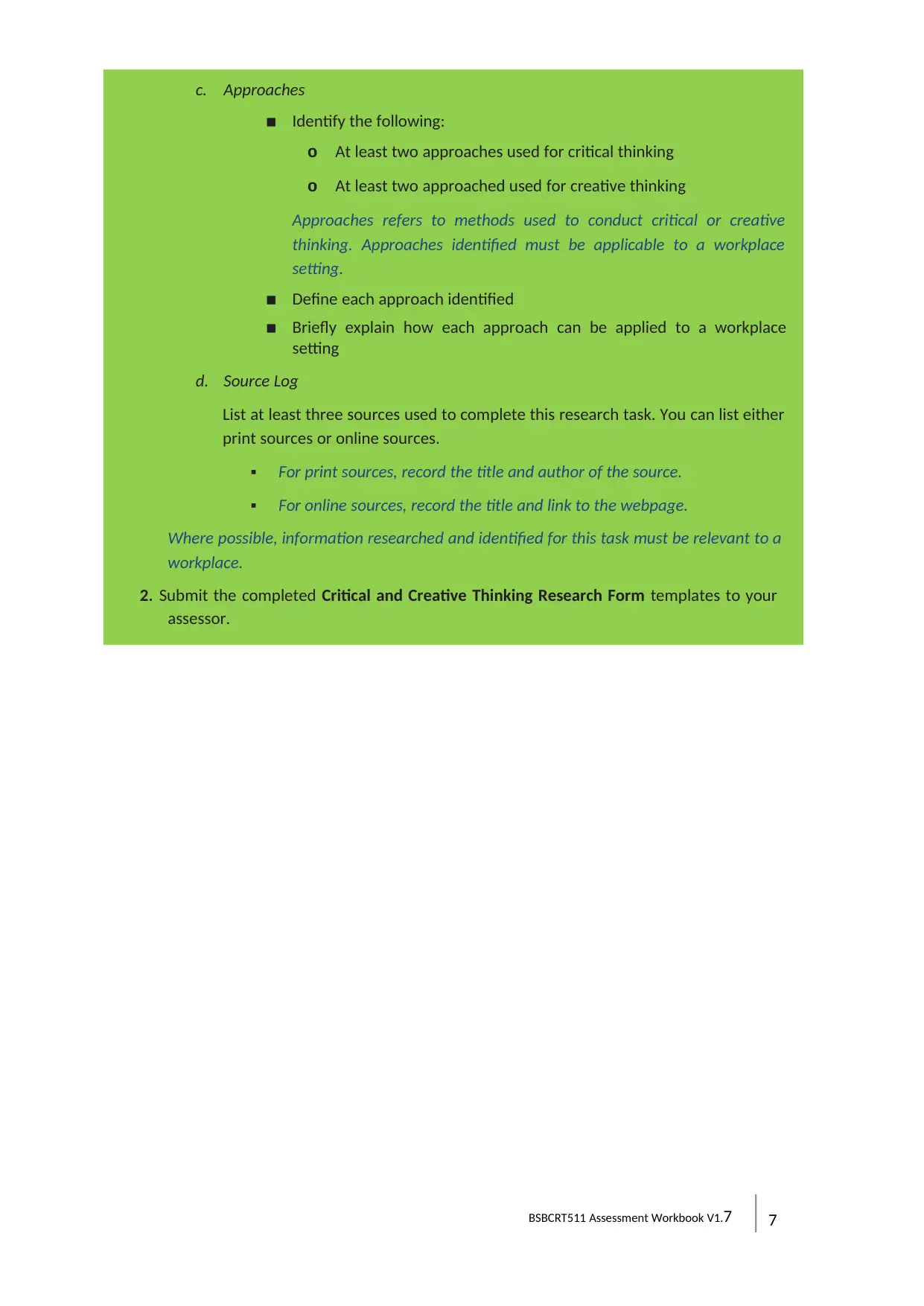
7BSBCRT511 Assessment Workbook V1.7
c. Approaches
▪ Identify the following:
o At least two approaches used for critical thinking
o At least two approached used for creative thinking
Approaches refers to methods used to conduct critical or creative
thinking. Approaches identified must be applicable to a workplace
setting.
▪ Define each approach identified
▪ Briefly explain how each approach can be applied to a workplace
setting
d. Source Log
List at least three sources used to complete this research task. You can list either
print sources or online sources.
▪ For print sources, record the title and author of the source.
▪ For online sources, record the title and link to the webpage.
Where possible, information researched and identified for this task must be relevant to a
workplace.
2. Submit the completed Critical and Creative Thinking Research Form templates to your
assessor.
c. Approaches
▪ Identify the following:
o At least two approaches used for critical thinking
o At least two approached used for creative thinking
Approaches refers to methods used to conduct critical or creative
thinking. Approaches identified must be applicable to a workplace
setting.
▪ Define each approach identified
▪ Briefly explain how each approach can be applied to a workplace
setting
d. Source Log
List at least three sources used to complete this research task. You can list either
print sources or online sources.
▪ For print sources, record the title and author of the source.
▪ For online sources, record the title and link to the webpage.
Where possible, information researched and identified for this task must be relevant to a
workplace.
2. Submit the completed Critical and Creative Thinking Research Form templates to your
assessor.
Paraphrase This Document
Need a fresh take? Get an instant paraphrase of this document with our AI Paraphraser
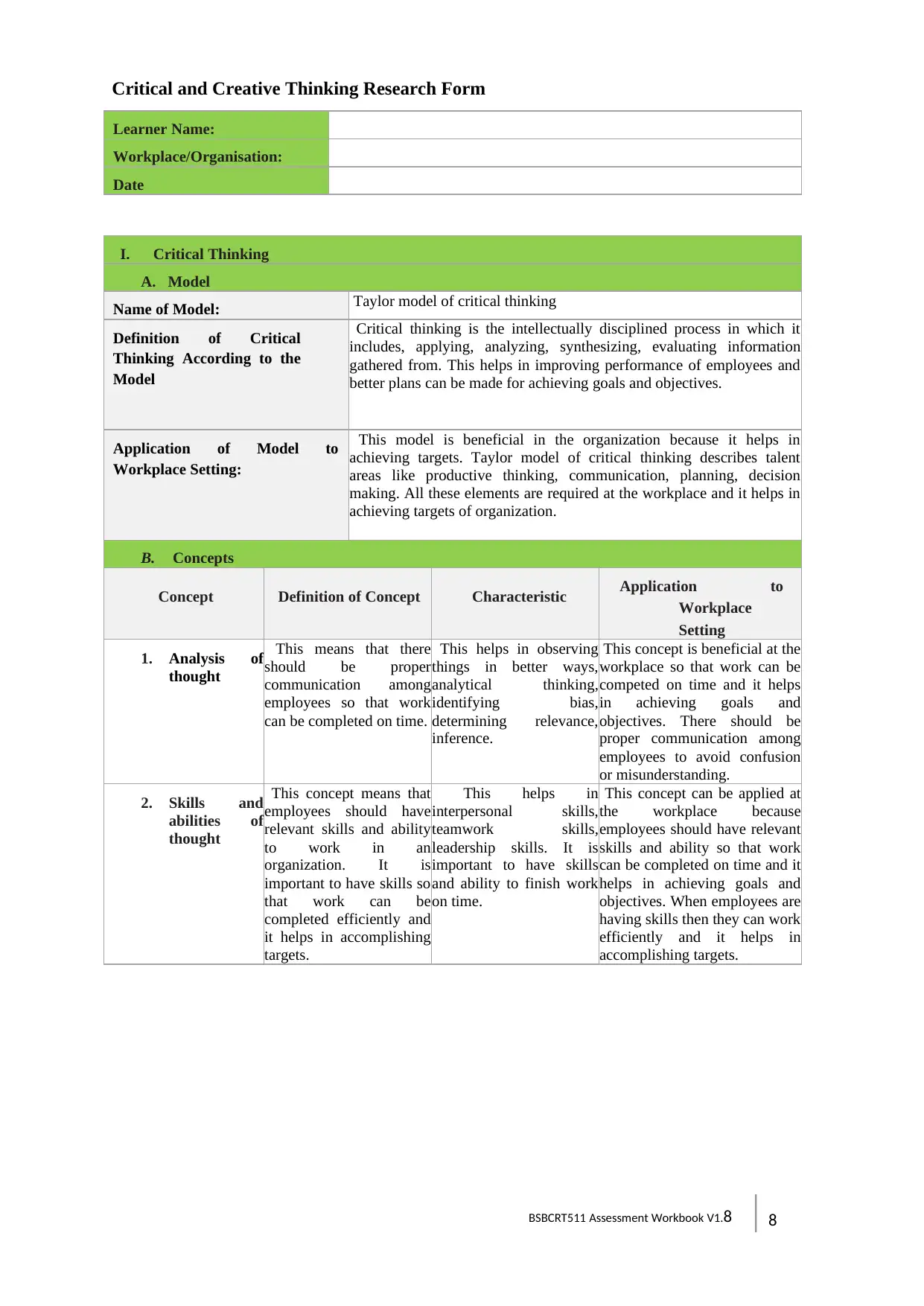
8BSBCRT511 Assessment Workbook V1.8
Critical and Creative Thinking Research Form
Learner Name:
Workplace/Organisation:
Date
I. Critical Thinking
A. Model
Name of Model: Taylor model of critical thinking
Definition of Critical
Thinking According to the
Model
Critical thinking is the intellectually disciplined process in which it
includes, applying, analyzing, synthesizing, evaluating information
gathered from. This helps in improving performance of employees and
better plans can be made for achieving goals and objectives.
Application of Model to
Workplace Setting:
This model is beneficial in the organization because it helps in
achieving targets. Taylor model of critical thinking describes talent
areas like productive thinking, communication, planning, decision
making. All these elements are required at the workplace and it helps in
achieving targets of organization.
B. Concepts
Concept Definition of Concept Characteristic Application to
Workplace
Setting
1. Analysis of
thought
This means that there
should be proper
communication among
employees so that work
can be completed on time.
This helps in observing
things in better ways,
analytical thinking,
identifying bias,
determining relevance,
inference.
This concept is beneficial at the
workplace so that work can be
competed on time and it helps
in achieving goals and
objectives. There should be
proper communication among
employees to avoid confusion
or misunderstanding.
2. Skills and
abilities of
thought
This concept means that
employees should have
relevant skills and ability
to work in an
organization. It is
important to have skills so
that work can be
completed efficiently and
it helps in accomplishing
targets.
This helps in
interpersonal skills,
teamwork skills,
leadership skills. It is
important to have skills
and ability to finish work
on time.
This concept can be applied at
the workplace because
employees should have relevant
skills and ability so that work
can be completed on time and it
helps in achieving goals and
objectives. When employees are
having skills then they can work
efficiently and it helps in
accomplishing targets.
Critical and Creative Thinking Research Form
Learner Name:
Workplace/Organisation:
Date
I. Critical Thinking
A. Model
Name of Model: Taylor model of critical thinking
Definition of Critical
Thinking According to the
Model
Critical thinking is the intellectually disciplined process in which it
includes, applying, analyzing, synthesizing, evaluating information
gathered from. This helps in improving performance of employees and
better plans can be made for achieving goals and objectives.
Application of Model to
Workplace Setting:
This model is beneficial in the organization because it helps in
achieving targets. Taylor model of critical thinking describes talent
areas like productive thinking, communication, planning, decision
making. All these elements are required at the workplace and it helps in
achieving targets of organization.
B. Concepts
Concept Definition of Concept Characteristic Application to
Workplace
Setting
1. Analysis of
thought
This means that there
should be proper
communication among
employees so that work
can be completed on time.
This helps in observing
things in better ways,
analytical thinking,
identifying bias,
determining relevance,
inference.
This concept is beneficial at the
workplace so that work can be
competed on time and it helps
in achieving goals and
objectives. There should be
proper communication among
employees to avoid confusion
or misunderstanding.
2. Skills and
abilities of
thought
This concept means that
employees should have
relevant skills and ability
to work in an
organization. It is
important to have skills so
that work can be
completed efficiently and
it helps in accomplishing
targets.
This helps in
interpersonal skills,
teamwork skills,
leadership skills. It is
important to have skills
and ability to finish work
on time.
This concept can be applied at
the workplace because
employees should have relevant
skills and ability so that work
can be completed on time and it
helps in achieving goals and
objectives. When employees are
having skills then they can work
efficiently and it helps in
accomplishing targets.
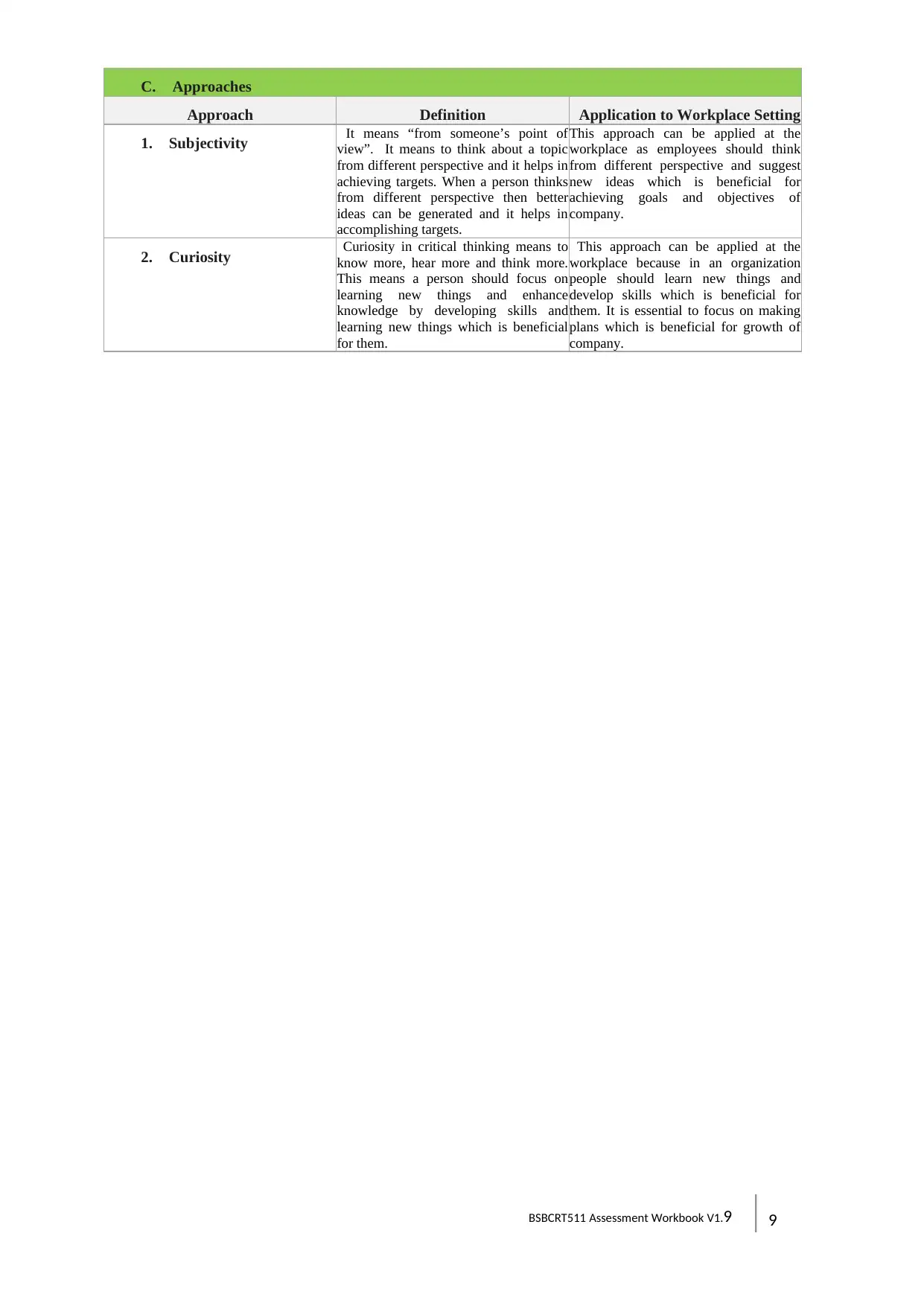
9BSBCRT511 Assessment Workbook V1.9
C. Approaches
Approach Definition Application to Workplace Setting
1. Subjectivity It means “from someone’s point of
view”. It means to think about a topic
from different perspective and it helps in
achieving targets. When a person thinks
from different perspective then better
ideas can be generated and it helps in
accomplishing targets.
This approach can be applied at the
workplace as employees should think
from different perspective and suggest
new ideas which is beneficial for
achieving goals and objectives of
company.
2. Curiosity Curiosity in critical thinking means to
know more, hear more and think more.
This means a person should focus on
learning new things and enhance
knowledge by developing skills and
learning new things which is beneficial
for them.
This approach can be applied at the
workplace because in an organization
people should learn new things and
develop skills which is beneficial for
them. It is essential to focus on making
plans which is beneficial for growth of
company.
C. Approaches
Approach Definition Application to Workplace Setting
1. Subjectivity It means “from someone’s point of
view”. It means to think about a topic
from different perspective and it helps in
achieving targets. When a person thinks
from different perspective then better
ideas can be generated and it helps in
accomplishing targets.
This approach can be applied at the
workplace as employees should think
from different perspective and suggest
new ideas which is beneficial for
achieving goals and objectives of
company.
2. Curiosity Curiosity in critical thinking means to
know more, hear more and think more.
This means a person should focus on
learning new things and enhance
knowledge by developing skills and
learning new things which is beneficial
for them.
This approach can be applied at the
workplace because in an organization
people should learn new things and
develop skills which is beneficial for
them. It is essential to focus on making
plans which is beneficial for growth of
company.
⊘ This is a preview!⊘
Do you want full access?
Subscribe today to unlock all pages.

Trusted by 1+ million students worldwide
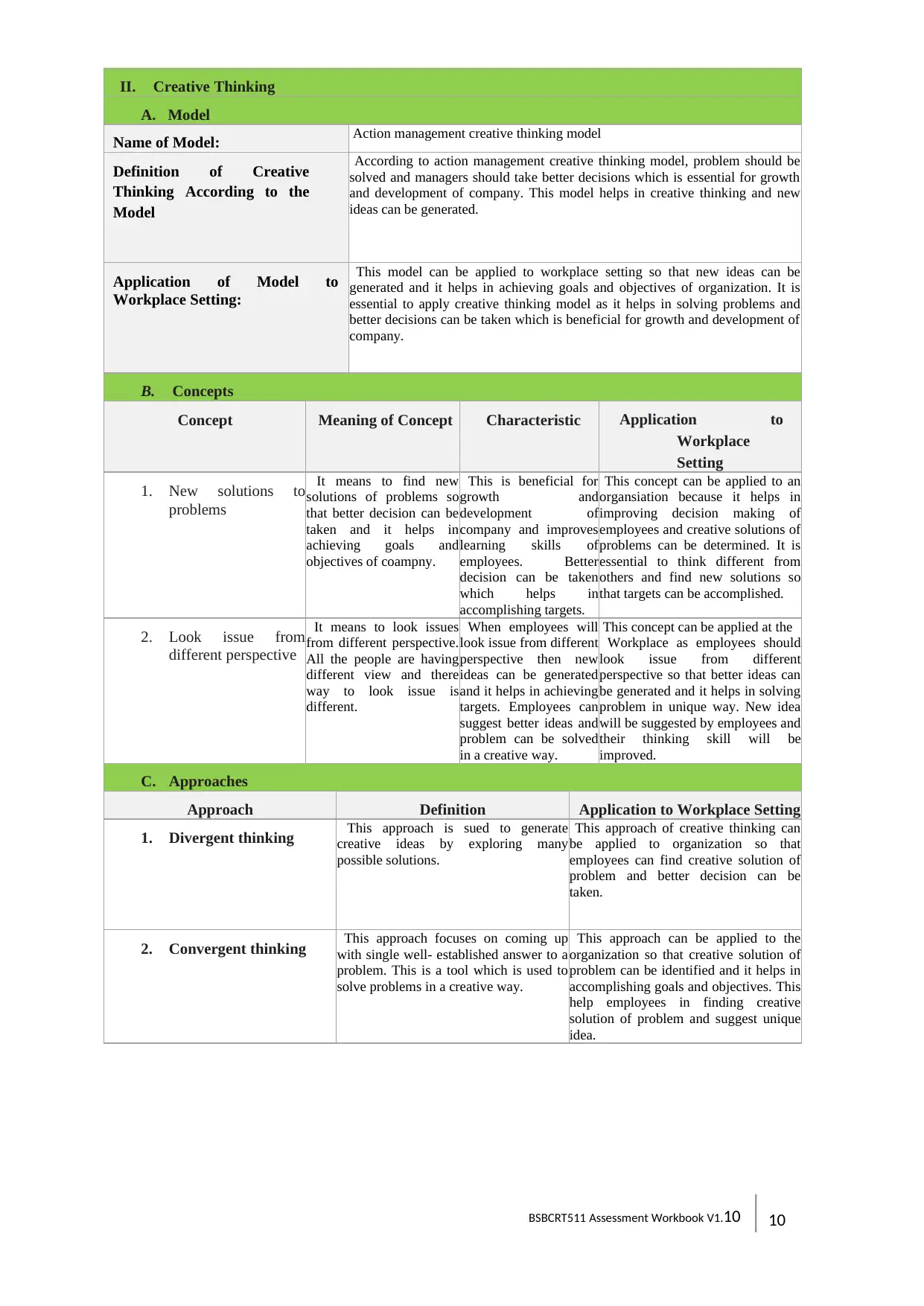
10BSBCRT511 Assessment Workbook V1.10
II. Creative Thinking
A. Model
Name of Model: Action management creative thinking model
Definition of Creative
Thinking According to the
Model
According to action management creative thinking model, problem should be
solved and managers should take better decisions which is essential for growth
and development of company. This model helps in creative thinking and new
ideas can be generated.
Application of Model to
Workplace Setting:
This model can be applied to workplace setting so that new ideas can be
generated and it helps in achieving goals and objectives of organization. It is
essential to apply creative thinking model as it helps in solving problems and
better decisions can be taken which is beneficial for growth and development of
company.
B. Concepts
Concept Meaning of Concept Characteristic Application to
Workplace
Setting
1. New solutions to
problems
It means to find new
solutions of problems so
that better decision can be
taken and it helps in
achieving goals and
objectives of coampny.
This is beneficial for
growth and
development of
company and improves
learning skills of
employees. Better
decision can be taken
which helps in
accomplishing targets.
This concept can be applied to an
organsiation because it helps in
improving decision making of
employees and creative solutions of
problems can be determined. It is
essential to think different from
others and find new solutions so
that targets can be accomplished.
2. Look issue from
different perspective
It means to look issues
from different perspective.
All the people are having
different view and there
way to look issue is
different.
When employees will
look issue from different
perspective then new
ideas can be generated
and it helps in achieving
targets. Employees can
suggest better ideas and
problem can be solved
in a creative way.
This concept can be applied at the
Workplace as employees should
look issue from different
perspective so that better ideas can
be generated and it helps in solving
problem in unique way. New idea
will be suggested by employees and
their thinking skill will be
improved.
C. Approaches
Approach Definition Application to Workplace Setting
1. Divergent thinking This approach is sued to generate
creative ideas by exploring many
possible solutions.
This approach of creative thinking can
be applied to organization so that
employees can find creative solution of
problem and better decision can be
taken.
2. Convergent thinking This approach focuses on coming up
with single well- established answer to a
problem. This is a tool which is used to
solve problems in a creative way.
This approach can be applied to the
organization so that creative solution of
problem can be identified and it helps in
accomplishing goals and objectives. This
help employees in finding creative
solution of problem and suggest unique
idea.
II. Creative Thinking
A. Model
Name of Model: Action management creative thinking model
Definition of Creative
Thinking According to the
Model
According to action management creative thinking model, problem should be
solved and managers should take better decisions which is essential for growth
and development of company. This model helps in creative thinking and new
ideas can be generated.
Application of Model to
Workplace Setting:
This model can be applied to workplace setting so that new ideas can be
generated and it helps in achieving goals and objectives of organization. It is
essential to apply creative thinking model as it helps in solving problems and
better decisions can be taken which is beneficial for growth and development of
company.
B. Concepts
Concept Meaning of Concept Characteristic Application to
Workplace
Setting
1. New solutions to
problems
It means to find new
solutions of problems so
that better decision can be
taken and it helps in
achieving goals and
objectives of coampny.
This is beneficial for
growth and
development of
company and improves
learning skills of
employees. Better
decision can be taken
which helps in
accomplishing targets.
This concept can be applied to an
organsiation because it helps in
improving decision making of
employees and creative solutions of
problems can be determined. It is
essential to think different from
others and find new solutions so
that targets can be accomplished.
2. Look issue from
different perspective
It means to look issues
from different perspective.
All the people are having
different view and there
way to look issue is
different.
When employees will
look issue from different
perspective then new
ideas can be generated
and it helps in achieving
targets. Employees can
suggest better ideas and
problem can be solved
in a creative way.
This concept can be applied at the
Workplace as employees should
look issue from different
perspective so that better ideas can
be generated and it helps in solving
problem in unique way. New idea
will be suggested by employees and
their thinking skill will be
improved.
C. Approaches
Approach Definition Application to Workplace Setting
1. Divergent thinking This approach is sued to generate
creative ideas by exploring many
possible solutions.
This approach of creative thinking can
be applied to organization so that
employees can find creative solution of
problem and better decision can be
taken.
2. Convergent thinking This approach focuses on coming up
with single well- established answer to a
problem. This is a tool which is used to
solve problems in a creative way.
This approach can be applied to the
organization so that creative solution of
problem can be identified and it helps in
accomplishing goals and objectives. This
help employees in finding creative
solution of problem and suggest unique
idea.
Paraphrase This Document
Need a fresh take? Get an instant paraphrase of this document with our AI Paraphraser
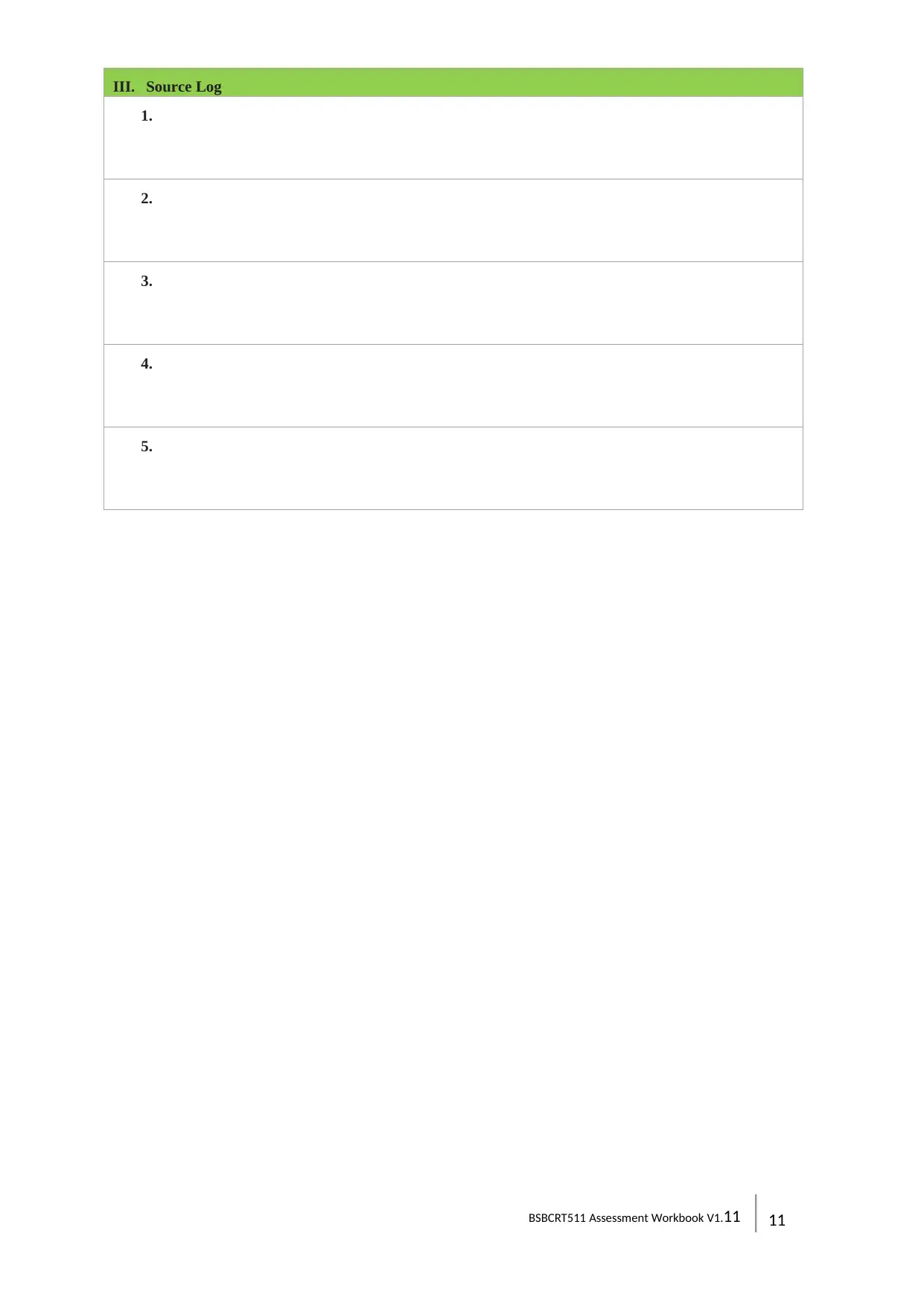
11BSBCRT511 Assessment Workbook V1.11
III. Source Log
1.
2.
3.
4.
5.
III. Source Log
1.
2.
3.
4.
5.
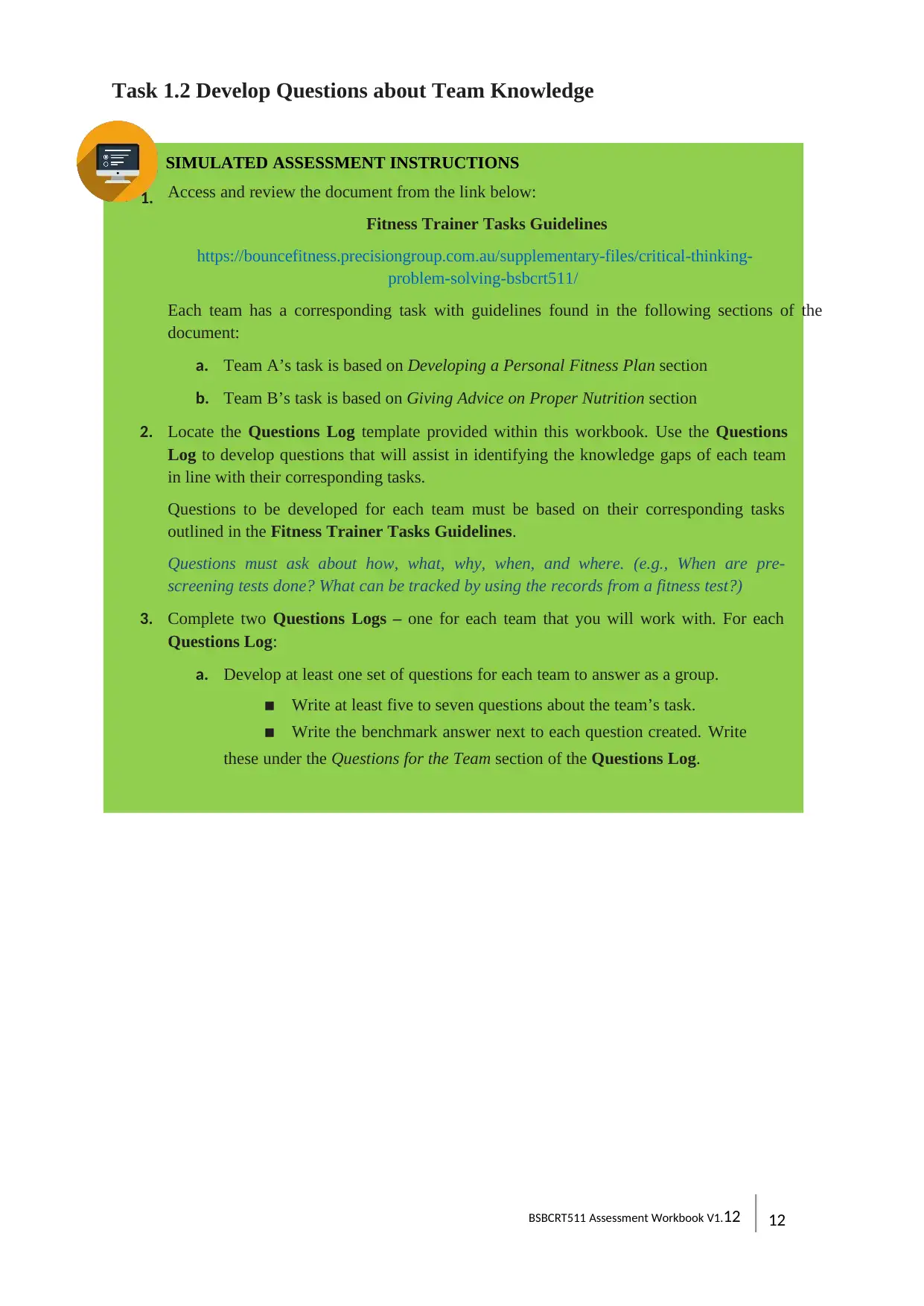
12BSBCRT511 Assessment Workbook V1.12
Task 1.2 Develop Questions about Team Knowledge
SIMULATED ASSESSMENT INSTRUCTIONS
Access and review the document from the link below:
Fitness Trainer Tasks Guidelines
https://bouncefitness.precisiongroup.com.au/supplementary-files/critical-thinking-
problem-solving-bsbcrt511/
Each team has a corresponding task with guidelines found in the following sections of the
document:
a. Team A’s task is based on Developing a Personal Fitness Plan section
b. Team B’s task is based on Giving Advice on Proper Nutrition section
2. Locate the Questions Log template provided within this workbook. Use the Questions
Log to develop questions that will assist in identifying the knowledge gaps of each team
in line with their corresponding tasks.
Questions to be developed for each team must be based on their corresponding tasks
outlined in the Fitness Trainer Tasks Guidelines.
Questions must ask about how, what, why, when, and where. (e.g., When are pre-
screening tests done? What can be tracked by using the records from a fitness test?)
3. Complete two Questions Logs – one for each team that you will work with. For each
Questions Log:
a. Develop at least one set of questions for each team to answer as a group.
▪ Write at least five to seven questions about the team’s task.
▪ Write the benchmark answer next to each question created. Write
these under the Questions for the Team section of the Questions Log.
1.
Task 1.2 Develop Questions about Team Knowledge
SIMULATED ASSESSMENT INSTRUCTIONS
Access and review the document from the link below:
Fitness Trainer Tasks Guidelines
https://bouncefitness.precisiongroup.com.au/supplementary-files/critical-thinking-
problem-solving-bsbcrt511/
Each team has a corresponding task with guidelines found in the following sections of the
document:
a. Team A’s task is based on Developing a Personal Fitness Plan section
b. Team B’s task is based on Giving Advice on Proper Nutrition section
2. Locate the Questions Log template provided within this workbook. Use the Questions
Log to develop questions that will assist in identifying the knowledge gaps of each team
in line with their corresponding tasks.
Questions to be developed for each team must be based on their corresponding tasks
outlined in the Fitness Trainer Tasks Guidelines.
Questions must ask about how, what, why, when, and where. (e.g., When are pre-
screening tests done? What can be tracked by using the records from a fitness test?)
3. Complete two Questions Logs – one for each team that you will work with. For each
Questions Log:
a. Develop at least one set of questions for each team to answer as a group.
▪ Write at least five to seven questions about the team’s task.
▪ Write the benchmark answer next to each question created. Write
these under the Questions for the Team section of the Questions Log.
1.
⊘ This is a preview!⊘
Do you want full access?
Subscribe today to unlock all pages.

Trusted by 1+ million students worldwide
1 out of 62
Related Documents
Your All-in-One AI-Powered Toolkit for Academic Success.
+13062052269
info@desklib.com
Available 24*7 on WhatsApp / Email
![[object Object]](/_next/static/media/star-bottom.7253800d.svg)
Unlock your academic potential
Copyright © 2020–2025 A2Z Services. All Rights Reserved. Developed and managed by ZUCOL.





